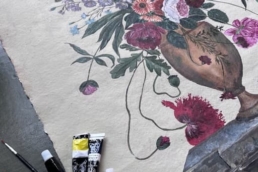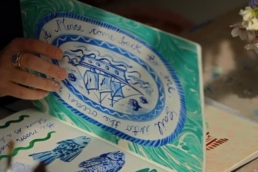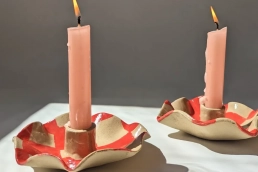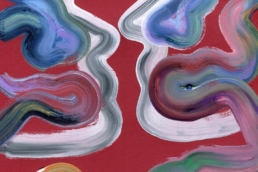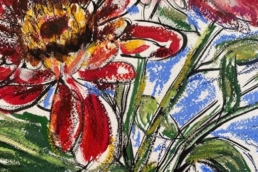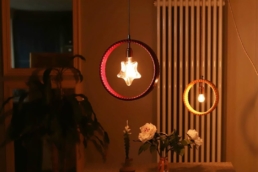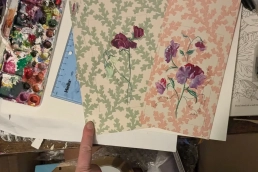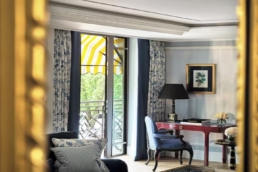We recently caught up with Daisy Tortuga, an artist whose practice spans craft-based mediums, exploring the playful and autobiographical through textiles, ceramics, and music. Daisy shares stories from her creative journey, from crafting waistcoats for her childhood cat to finding catharsis in tufted rugs. We delve into how limitations fuel her creativity, her love for outsider and folk art, and the balance between experimentation and practicality. Daisy offers thoughtful insights on finding joy and authenticity in making art and embracing one’s unique path.
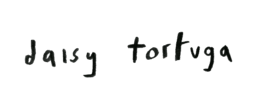
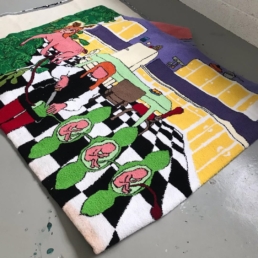
1. Can you tell us a bit about yourself and your artistic journey?
I have always enjoyed making things, it’s the only thing I have ever felt good at. I would describe myself as an artist that enjoys working in craft based mediums. I’ve never liked painting or drawing particularly, I think with craft mediums there is always a limitation with the material which makes me more excited than the endless possibility of paint colours for example. I like to use tangible materials like fabric, wool and clay; using their limitations to tell stories.
2. What inspired you to pursue your craft? Was there a defining moment or influence that sparked your passion?
My earliest memory of craft was making clothes for my cat Apricot when I was 5 or 6. I wasn’t able to sew yet but I stapled the seams together and made him a collection of waistcoats. My practice isn’t miles away from this now, not that I make clothing for animals but my work is very much led by what I feel like making at that time. My work has a connection of shared visual language but crosses many materials and forms.

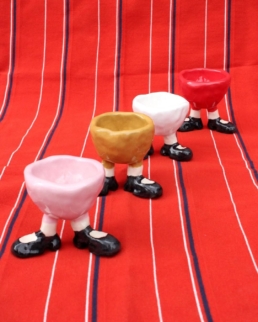
Your craft
3. How would you describe your work in three words?
playful, autobiographical, tactile
4. What materials or techniques do you use, and why are they important to your process?
I work mainly in tufted rug using wool, knitting using a domestic knitting machine and in clay. These materials are important to me because they allow me to make illustrations but through more tactile materials than just paper and pen. As previously mentioned, the materials all have limitations, for example when making a rug my frame can only make a certain size, the yarn colours are already dyed and so deciding what to do within these limitations is what I work within. Also using traditionally female techniques is something I feel connected to and continuing this tradition is something I’m interested in. I am also a songwriter and musician, for me my music lives in the same world I have created visually.
5. Can you tell us about a favourite piece you’ve created and the story behind it?
My favourite collection of work I have made was an exhibition I did called ‘New Rug, New Me’ in 2021 at The Truman Brewery in Shoreditch. I had a period of time constantly making rugs with autobiographical stories throughout and the work was made compulsively and in complete flow. I was extremely unhappy at the time and found catharsis in the body of work.
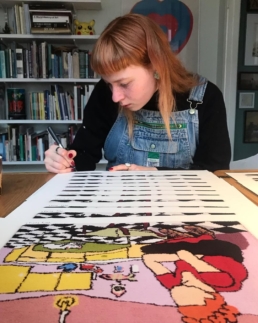
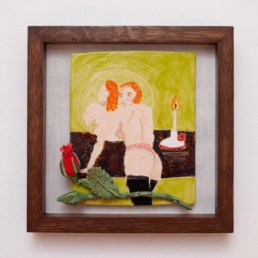
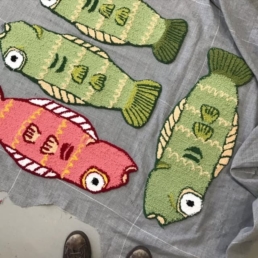
Creative process
6. What does a typical day in your studio or workshop look like?
I get to my studio around 10 am. I’m quite absorbed in my work when I’m working and don’t tend to procrastinate. I take cigarette breaks, make to-do lists, listen to podcasts and occasionally watch crap TV. I leave the studio at around 6 pm
7. Do you have any unique rituals or habits that help you stay creative?
Cigarettes
8. How do you handle creative blocks? Do you have any strategies or tips for overcoming them?
I find not working for a while the best thing for a block. Not being allowed to make work can make you miss it.
Challenges and successes
9. What’s the biggest challenge you’ve faced as a maker, and how did you overcome it?
Needing to make money at the same time as trying to experiment and take risks within my practice – still working on this
10. What’s been your proudest moment or achievement so far?
Finding my work in a charity shop
11. What’s your favourite quote you’ve ever heard about your work? Who said it, or what was the name of the publication?
‘Bitterly vindictive yet ultimately charming’
- Hard of Hearing Magazine about my bands EP
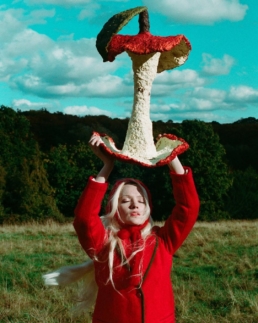
Inspiration
12. Where do you draw inspiration from for your work? What sparks your imagination and creativity?
I’m interested in outsider art/folk art. I think work made intuitively and without the intention of an audience is most interesting. I find myself inspired by literature, music and domestic spaces.
13. Do you have a favourite artist, maker, movement, or tradition that has influenced your craft?
I think craft work by women is an area of interest for me. Victorian needle point, handicrafts etc. This work was never considered art and I believe this is where the most pure, inventive creation can come. When there is no great intention of audience.
14. How does colour influence your practice; is it an important part of your process? Do you have a particular palette or favourites? Any go-to sources for colour inspiration?
My work definitely has a lot of colour, i’m not sure about a particular palette, I just add colours quite freely and don’t think about them too much.
Perspectives and goals
15. What role does your environment play in shaping your creativity?
I like to be alone when i’m working. I also like to wear headphones and be completely absorbed in what i’m doing, not distracted by phone messages etc. My studio also needs to be a place I feel safe and is decorated to my liking.
16. What do you want people to feel when they experience your work?
I’d like people to feel a sense of connection to something they might have experienced, like a story or character that resonates with them. Or simpler than that just an object that brings them joy.
17. What are you currently working on, and what excites you most about it?
I’m going to work on some more self portraits this year, I hope to make some vases a bit more similar to my textile work. I also want to make a collection of jumpers.
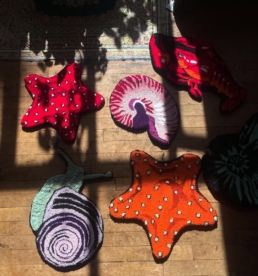
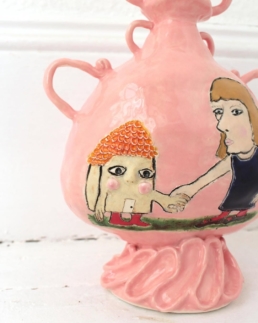
Advice and reflection
18. What advice would you give to someone starting out as a maker?
Do your own thing. Try not to follow trends
19. If you could go back to the start of your career, what advice would you give your younger self?
If I could tell myself at 16 that I could be a professional artist I would have been very pleased. I didn’t know I would be able to be a full time artist, I had never met anyone who had a creative job. I think its good to remember there are so many jobs involved in the creative world and you can always find your niche.
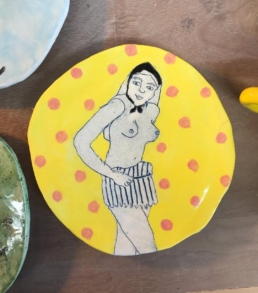
Closing thoughts
20. If you could collaborate with any artist, past or present, who would it be and why?
Black Sabbath
21. Where can people find your work, and how can they support you?
They can support me on my website daisytortuga.com or over on Instagram.
Daisy Tortuga’s vibrant, tactile artworks blend storytelling, playful exploration, and heartfelt connection, creating pieces that resonate deeply with everyday experiences. Her multidisciplinary approach crosses boundaries, offering joyful and introspective pieces that invite personal connection and warmth.
Explore Daisy’s latest collections and follow her creative journey:
Support Daisy by visiting her website, following her on Instagram, and staying tuned for her exciting new projects.


